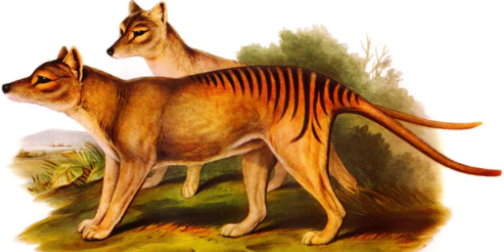http://1.bp.blogspot.com/-cw0gGouS668/Wi-hbajCcdI/AAAAAAAAMZs/ziwnJGY9b98uGts9_swLO-HQB5xx3_nNwCK4BGAYYCw/s1600/2017-12-12_14-56-34.png

The first full genetic blueprint of the long-extinct thylacine has revealed the animal suffered from genetic weakness well before it was isolated on Tasmania 10,000 to 13,000 years ago.
An international team of researchers led by associate professor Andrew Pask from the University of Melbourne used DNA from the 106-year-old preserved remains of a juvenile thylacine or Tasmanian tiger to sequence the animal’s genome, making it one of the most complete genetic blueprints for an extinct species.
Their findings, published in the journal Nature, provide new information on the biology of the unique marsupial and reveal that the population was in danger long before it came in contact with humans.
“We’ve always known that the Tasmanian tiger did not have much genetic diversity, so it would be more susceptible to diseases,” he said.
“It’s very much like the Tasmanian devil in that respect and we’ve always thought that happened once it became isolated on Tasmania between 10,000 and 15,000 years ago.
“But what we found is that the population declined about 70,000 years ago, long before it was isolated meaning it probably had more to do with changes in the climate back then.”
While overhunting was “without doubt” responsible for the animal’s extinction in 1936, Pask said its genetic weakness would have made it more susceptible to disease had it survived.
He said that while researchers were still a long way from bringing the animal back from extinction it was a “major hurdle” cleared. The information could help efforts to protect the Tasmanian devil because researchers could use it to infer what a healthy marsupial’s genome should look like.
The researchers also found that despite its similarities to the Australian dingo, the thylacine’s DNA actually has more in common with the kangaroo.
Scientists consider the thylacine and the dingo as one of the best examples of what’s known as “convergent evolution”, the process where organisms that are not closely related independently evolve to look the same as a result of having to adapt to similar environments or ecological niches.
Because of their hunting technique and diet of fresh meat, their skulls and body shape became similar despite the Tasmanian tiger’s DNA having more in common with a kangaroo.
Pask said the genome showed the Tasmanian tiger was an “unbelievable” example of convergent evolution, because it proved how distant the two species were.
“Their similarities are absolutely astounding because they haven’t shared a common ancestor since the Jurassic period, 160m years ago,” he said.
“The appearance of the thylacine is almost a dingo with a pouch. And when we looked at the basis for this convergent evolution, we found that it wasn’t actually the genes themselves that produced the same skull and body shape, but the control regions around them that turn genes ‘on and off’ at different stages of growth.
“This reveals a whole new understanding of the process of evolution, we can now explore these regions of the genome to help understand how two species converge on the same appearance, and how the process of evolution works.”
guardian.co.uk © Guardian News & Media Limited 2010
Published via the Guardian News Feed plugin for WordPress.
Thylacine DNA reveals weakness – and kinship with the kangaroohttps://goo.gl/FEXYZR











0 comments:
Post a Comment